TAPIRS ARE SO COOL
And Costa Rica Is Their Last Best Hope for Survival
By Jack Ewing
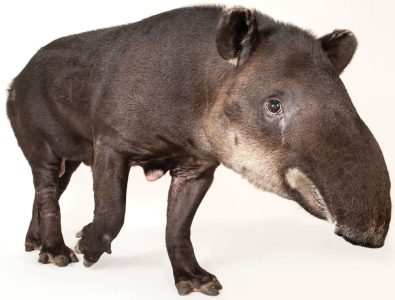 Biologist and tapir specialist, Charlie Foerster, once told me about an experience he had while standing on a high spot looking down over an embankment into a river when a tapir walked across a shallow area and continued into a deep pool until its head was submerged. Its elongated nose stuck out of the water like a snorkel until the animal reached the deepest part of the pool, and it too went under the surface. The water was clear and Charlie could see hordes of small fish surround the tapir and peck away at all of the ticks, lice and other external parasites attached to its hide, while the tapir blew bubbles. After a while the large mammal surfaced, took several deep breaths and sunk back to the bottom repeating the process a couple more times. Finally it walked out of the pool free of all its unwelcome hitchhikers. Now that’s what I call cool.
Biologist and tapir specialist, Charlie Foerster, once told me about an experience he had while standing on a high spot looking down over an embankment into a river when a tapir walked across a shallow area and continued into a deep pool until its head was submerged. Its elongated nose stuck out of the water like a snorkel until the animal reached the deepest part of the pool, and it too went under the surface. The water was clear and Charlie could see hordes of small fish surround the tapir and peck away at all of the ticks, lice and other external parasites attached to its hide, while the tapir blew bubbles. After a while the large mammal surfaced, took several deep breaths and sunk back to the bottom repeating the process a couple more times. Finally it walked out of the pool free of all its unwelcome hitchhikers. Now that’s what I call cool.
The Central American Tapir (Tapirus bairdii) sometimes called Baird’s Tapir, is the largest land mammal in Central and South America. They are about the size of a small cow—an adult will weigh up to 350 kg—but are shaped more like a pig. A long, prehensile snout, that has also been called a short trunk, is used to grasp vegetation and pull it into the tapir’s mouth. The front feet have three large toes and a fourth smaller toe located a little bit higher on the foot. The back feet have only three toes. This puts them in the same family as the horse and rhinoceros, the odd-toed ungulates. They love water and are seldom found far from it.
Though their diet includes many species of undergrowth plants they truly love fruit of many different kinds which they seek out wherever it may fall. When a tapir consumes fruit it often swallows the seeds whole and later passes them out with the feces when defecating. Tapir dung serves as fertilizer for the young seedlings that sprout up when the seeds germinate. In addition to dispersing seeds throughout the jungle, the tapir also performs a valuable service to the forest by opening up small clearings in the undergrowth thus allowing sunlight to enter and a multitude of plants to spring up. These two habits have earned the tapir the nickname of “Gardener of the Rainforest”.
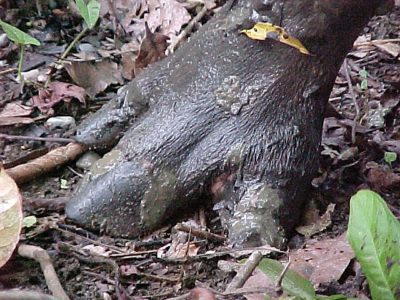 There are only around 4500 Baird’s Tapirs in the world distributed among five Central American countries, and Mexico and Columbia. There may also be a few in El Salvador and Ecuador. About 1000 of them are estimated to survive in Costa Rica. And tapirs definitely are survivors. They have been around for over 30 million years and have survived at least 30 ice age cycles. They survived the wave of human hunters that crossed the Bearing Straight 14 to 12 thousand years ago and killed off the mammoths, mastodons, giant sloths, giant bison and numerous other large animals. Up until now they have survived Homo sapiens’ insatiable lust for land and overwhelming desire to kill every wild animal that inhabits the forest. I believe that Costa Rica is the Central American Tapir’s last best hope for survival, and in spite of the threats they face, I am optimistic that these large charismatic mammals will persevere. They may even be around after our own species has ceased to exist.
There are only around 4500 Baird’s Tapirs in the world distributed among five Central American countries, and Mexico and Columbia. There may also be a few in El Salvador and Ecuador. About 1000 of them are estimated to survive in Costa Rica. And tapirs definitely are survivors. They have been around for over 30 million years and have survived at least 30 ice age cycles. They survived the wave of human hunters that crossed the Bearing Straight 14 to 12 thousand years ago and killed off the mammoths, mastodons, giant sloths, giant bison and numerous other large animals. Up until now they have survived Homo sapiens’ insatiable lust for land and overwhelming desire to kill every wild animal that inhabits the forest. I believe that Costa Rica is the Central American Tapir’s last best hope for survival, and in spite of the threats they face, I am optimistic that these large charismatic mammals will persevere. They may even be around after our own species has ceased to exist.
Why have tapirs survived this long? To begin with they don’t have a lot of natural predators. Only the jaguar, puma, and crocodile are capable of killing a tapir, and it isn’t an easy task even for one of them. Though clumsy in appearance the tapir is very adept at sprinting, dodging, and maneuvering through the forest when pursued by a large predator. Even if a cat catches one, pulling it down and killing it is extremely difficult as an adult tapir’s mass is double that of a large feline. Human hunters kill them when the opportunity presents itself but don’t specifically seek them out. Tapir meat is edible, but not as tasty as white-lipped peccary, therefore they aren’t hunted with such enthusiasm.
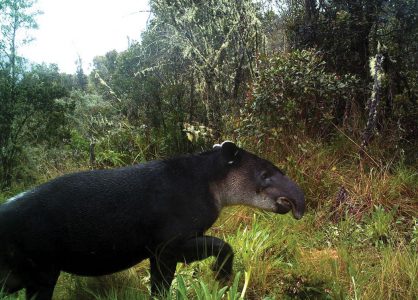 Adaptability is, by far, the tapir’s most valuable survival tool. Ever since its very beginnings our planet has been a place of constant change, and those creatures which were able to adapt to change survived, and those that couldn’t perished. In Costa Rica tapirs are found from sea level in Corcovado and Tortuguero to the the upper slopes of Chirripo and the Talamanca mountain range, an elevation of over 3500 meters. The available vegetation differs at every level as does the tapir’s diet. Variations in temperature and precipitation are considerable. The terrain in Corcovado may be flat and sandy, Tortuguero swampy, and Talamanca steep and rocky. Yet tapirs thrive in all of them. Rainforest, wet forest, dry forest, cloud forest, premontane forest, and montane forest all provide habitat for tapirs. The one thing they can’t do without is the forest. They are creatures of the forest, and the destruction of that habitat is the greatest threat to their survival.
Adaptability is, by far, the tapir’s most valuable survival tool. Ever since its very beginnings our planet has been a place of constant change, and those creatures which were able to adapt to change survived, and those that couldn’t perished. In Costa Rica tapirs are found from sea level in Corcovado and Tortuguero to the the upper slopes of Chirripo and the Talamanca mountain range, an elevation of over 3500 meters. The available vegetation differs at every level as does the tapir’s diet. Variations in temperature and precipitation are considerable. The terrain in Corcovado may be flat and sandy, Tortuguero swampy, and Talamanca steep and rocky. Yet tapirs thrive in all of them. Rainforest, wet forest, dry forest, cloud forest, premontane forest, and montane forest all provide habitat for tapirs. The one thing they can’t do without is the forest. They are creatures of the forest, and the destruction of that habitat is the greatest threat to their survival.
Why do I say that Costa Rica is the tapir’s last best chance for survival? To begin with we already have more than 20% of the world population. Secondly about half of our national territory is in forest, and more than half of that is protected in national parks, national wildlife refuges, biological reserves and forest reserves. Nearly all of these protected areas are connected together by 44 different biological corridors. About half of the protected areas harbor tapirs. When Charlie Foerster was working in Corcovado, up until about 2005, he estimated that there were around 400 tapirs in the Osa Peninsula. If the number of tapir sightings by tourists is any indication, the population in 2018 is at least the same and probably greater. Also, since 2012, Dr. Mike Mooring of the Quetzal Research Center has placed trail cameras in the Quetzales, Tapantí, and Chirripo national parks in colaboration with the Costa Rican Wildlife Department and with local organizations. He assured me that the tapir population seems to be quite healthy in that area and is probably increasing.
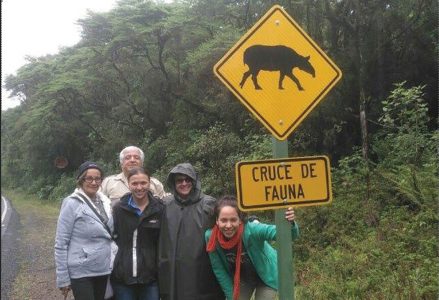 Tragically 23 of these majestic beasts have been killed on the interamerican highway in the last 7 years, effectively offsetting much of the population increase that may have occurred. Nãi Conservation is doing great work in the protected areas on both sides of the interamerican highway between Macizo de la Muerte and Rio Macho, and they are striving to find a solution to the problem.
Tragically 23 of these majestic beasts have been killed on the interamerican highway in the last 7 years, effectively offsetting much of the population increase that may have occurred. Nãi Conservation is doing great work in the protected areas on both sides of the interamerican highway between Macizo de la Muerte and Rio Macho, and they are striving to find a solution to the problem.
During the 1940s and 50s and continuing up until the mid-1980s about 80% of the area between the Savegre River and the Osa Peninsula was deforested for farming and ranching thus eliminating most of the tapir’s habitat. The last tapir in this area was killed by a hunter in 1957. In the late 80s the trend reversed, and much of the deforested land was abandoned to the whims of Mother Nature. It became overgrown with natural vegetation, and later evolved into secondary forest. Since 1990 the Path of the Tapir Biological Corridor Project has been striving to restore natural habitat to once denuded land in an effort to bring back the tapir’s habitat and the tapirs themselves. It forms the link between the Los Santos Forest Reserve and the Osa Peninsula both of which have healthy populations of tapirs. They haven’t returned to the corridor yet, but they do occasionally wander into the area, and a number of them have been sighted in recent years. In my opinion it’s only a matter of time before Central American Tapirs become permanent residents once again.
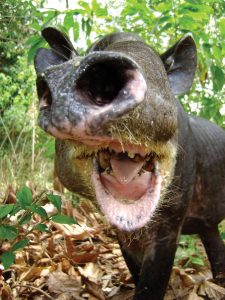 Tapirs are not only worth saving, but they are just plain cool. Dr. Mike Mooring says that they are lots of fun to photograph with trail cameras because they are quite curious, and it’s not unusual for them to nuzzle the camera and even slobber all over it. One of the photos shows one checking out a camera, and another shows the end of a tapir’s nose sniffing the lens.
Tapirs are not only worth saving, but they are just plain cool. Dr. Mike Mooring says that they are lots of fun to photograph with trail cameras because they are quite curious, and it’s not unusual for them to nuzzle the camera and even slobber all over it. One of the photos shows one checking out a camera, and another shows the end of a tapir’s nose sniffing the lens.
I had the good fortune to spend three days in Corcovado National Park with biologist and tapir specialist Charlie Foerster in 2003. Though he had radio collared five different tapirs Charlie’s favorite subject was a large female he called Big Mama. In Chapter 20 of my book, Monkeys Are Made of Chocolate, I told the story of the time she walked into Charlie’s house in the middle of the night and gobbled up an entire bunch of bananas that he had left on the kitchen table. Nothing he did would convince her to leave until she had consumed every last banana. At that time Big Mama had been under study for 10 years during which time she had given birth to six offspring.
I quote from the book:
Her original mate was called Flash so named because of a mark shaped like a lightning bolt on his rear end. Three years ago Flash died, probably of old age, and Charlie buried him. For nearly three months Big Mama returned regularly to the grave site. “She would lie there like a grieving widow,” recalls Charlie, “with her head laid out flat on the bare dirt covering her deceased mate’s grave.
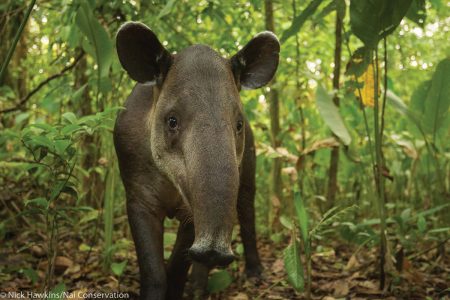 Within a month of Flash’s death several new males moved into the area and started courting Big Mama, even though she was not in estrus. She eventually selected a young male who Charlie named Thor. Once she made her choice the others left, and she remained faithful to Thor for the rest of the time that Charlie remained in Corcovado, about five years.
Within a month of Flash’s death several new males moved into the area and started courting Big Mama, even though she was not in estrus. She eventually selected a young male who Charlie named Thor. Once she made her choice the others left, and she remained faithful to Thor for the rest of the time that Charlie remained in Corcovado, about five years.
I have never read any biological text that would indicate that Central American Tapirs are monogamous, but it seems that at the very least Big Mama was. My guess is that this is another example of their tremendous ability to adapt. When there is an ecological advantage to being monogamous they are, and in situations where it is a detriment they aren’t.
If you still have any doubts about tapirs being cool I have it on good authority that both male and female tapirs love Calvin Klein’s “Obsession for Men”. How do I know this? Well, that’s a story for another time.
Author’s Note: A big thanks to Mike Mooring PhD and also to Nãi Conservation for most of the photos.

